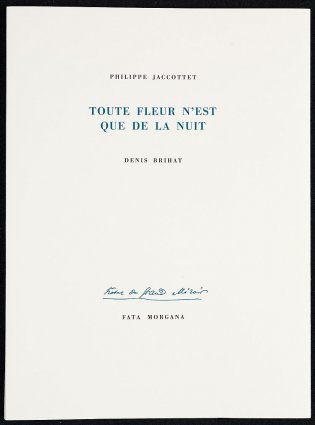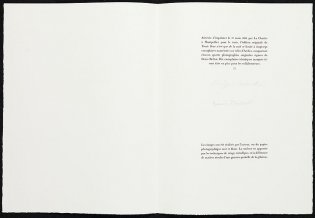Toute fleur n'est que de la nuit
Year: 2001
Author: Philippe Jaccottet (1925 - 2021)
Artist: Denis Brihat (*1928)
Publisher: Fata Morgana
Humble objects
Denis Brihat wanted his photos to embellish the wall as 'poetic decorations', having fled the world of commercial photography early in his career. He moved to Bonnieux, a little village in the Provence surrounded by nature, to work 'on small pieces of nature, flowers or vegetables, more a kind of portrait than still life'.
The photographs in Toute fleur n'est que de la nuit reveal berry branches, leaves and flowers in sepia, black, white and silver tints. Although they sometimes resemble 'humble objects' according to Brihat, they still contain an entire universe inside them. The power of Brihat's work is often described by quoting Flaubert's characteristic phrase: 'Anything becomes interesting if you look at it long enough.' A similar idea is expressed by the poem 'Oiseaux, fleurs et fruits' by Jaccottet, which opens this edition: 'Every colour, every life is born where a gaze comes to rest.' Brihat saw it as his duty to discover and reveal the rich beauty of nature. He regards photography as the sum of mechanical, chemical and optical techniques. The intensive, time-consuming processes he uses are all part of the craft that he considered photography to be. Brihat experimented with various tinting techniques in order to add colour artificially to photographs that were originally black-and-white. The photos in Toute fleur n'est que de la nuit were also coloured by using metal alloys, like gold, copper and selenium. The gelatine in the photographs' top layer was treated chemically to create more clarity and depth in the prints.
The commentary emphasizes the poetic and delicate qualities of his work: 'Each of his pictures is a poem – almost a haiku,' wrote Sue Davies. Candace Dwan wrote: 'The zen-like purity of focus, sense of delicacy and the sublime, resonates throughout the work.'

![Gedicht door Philippe Jaccottet (p. [3])](/sites/default/files/styles/galerie/public/images/toute-fleur-nest-que-de-la-nuit-p3.jpg?h=bdeacb1c&itok=dvd2wceI)
![Foto door Denis Brihat (p. [7])](/sites/default/files/styles/galerie/public/images/toute-fleur-nest-que-de-la-nuit-p7.jpg?h=e7495fab&itok=tQybXbC1)
![Foto door Denis Brihat (p. [9])](/sites/default/files/styles/galerie/public/images/toute-fleur-nest-que-de-la-nuit-p9.jpg?h=db6fbed2&itok=11bMEiyg)
